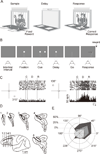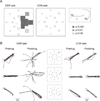The prefrontal cortex and oculomotor delayed response: a reconsideration of the "mnemonic scotoma"
- PMID: 22098265
- PMCID: PMC3269537
- DOI: 10.1162/jocn_a_00171
The prefrontal cortex and oculomotor delayed response: a reconsideration of the "mnemonic scotoma"
Abstract
The concept of the "mnemonic scotoma," a spatially circumscribed region of working memory impairment produced by unilateral lesions of the PFC, is central to the view that PFC is critical for the short-term retention of information. Presented here, however, are previously unpublished data that offer an alternative, nonmnemonic interpretation of this pattern of deficit. In their study, Wajima and Sawaguchi [Wajima, K., & Sawaguchi, T. The role of GABAergic inhibiton in suppressing perseverative responses in the monkey prefrontal cortex. Neuroscience Research, 50(Suppl. 1), P3-P317, 2004] applied the GABA(A) antagonist bicuculline methiodide unilaterally to the PFC of two monkeys while they performed an oculomotor delayed-response task. Consistent with previous studies, errors for the initial memory-guided saccade were markedly higher when the cued location fell into the region of the visual field affected by the infusion. These erroneous saccades tended to select an alternative target location (out of a possible 16) that had not been cued on that trial. By extending the analysis window, however, it was observed that the second, "corrective" saccade often acquired the location that had been cued on that trial. Further analysis of the erroneous initial saccades indicated that they tended to be directed to a location that had been relevant on the previous trial. Thus, the deficit was not one of "forgetting" the cued location. Rather, it was one of selecting between currently and previously relevant locations. These findings suggest a need for a reconsideration of the concept of the mnemonic scotoma, which in turn invites a reconsideration of functional interpretations of sustained neuronal activity in PFC.
Figures



Similar articles
-
Functions of delay-period activity in the prefrontal cortex and mnemonic scotomas revisited.Front Syst Neurosci. 2015 Feb 5;9:2. doi: 10.3389/fnsys.2015.00002. eCollection 2015. Front Syst Neurosci. 2015. PMID: 25698942 Free PMC article. Review.
-
The role of D1-dopamine receptor in working memory: local injections of dopamine antagonists into the prefrontal cortex of rhesus monkeys performing an oculomotor delayed-response task.J Neurophysiol. 1994 Feb;71(2):515-28. doi: 10.1152/jn.1994.71.2.515. J Neurophysiol. 1994. PMID: 7909839
-
Dorsolateral prefrontal lesions and oculomotor delayed-response performance: evidence for mnemonic "scotomas".J Neurosci. 1993 Apr;13(4):1479-97. doi: 10.1523/JNEUROSCI.13-04-01479.1993. J Neurosci. 1993. PMID: 8463830 Free PMC article.
-
Neuronal activity representing visuospatial mnemonic processes associated with target selection in the monkey dorsolateral prefrontal cortex.Neurosci Res. 2002 May;43(1):9-22. doi: 10.1016/s0168-0102(02)00013-5. Neurosci Res. 2002. PMID: 12074837
-
Control of the superior colliculus by the lateral prefrontal cortex.Philos Trans R Soc Lond B Biol Sci. 2013 Sep 9;368(1628):20130068. doi: 10.1098/rstb.2013.0068. Print 2013 Oct 19. Philos Trans R Soc Lond B Biol Sci. 2013. PMID: 24018729 Free PMC article. Review.
Cited by
-
Dopamine and eye movement control in Parkinson's disease: deficits in corollary discharge signals?PeerJ. 2018 Dec 7;6:e6038. doi: 10.7717/peerj.6038. eCollection 2018. PeerJ. 2018. PMID: 30568856 Free PMC article.
-
Role of the left hemisphere in visuospatial working memory.J Neurolinguistics. 2018 Nov;48:133-141. doi: 10.1016/j.jneuroling.2018.04.006. Epub 2018 May 18. J Neurolinguistics. 2018. PMID: 31341351 Free PMC article.
-
Autonomous encoding of irrelevant goals and outcomes by prefrontal cortex neurons.J Neurosci. 2014 Jan 29;34(5):1970-8. doi: 10.1523/JNEUROSCI.3228-13.2014. J Neurosci. 2014. PMID: 24478376 Free PMC article.
-
Neuromodulation of Prefrontal Cortex in Non-Human Primates by Dopaminergic Receptors during Rule-Guided Flexible Behavior and Cognitive Control.Front Neural Circuits. 2017 Dec 5;11:91. doi: 10.3389/fncir.2017.00091. eCollection 2017. Front Neural Circuits. 2017. PMID: 29259545 Free PMC article. Review.
-
Functions of delay-period activity in the prefrontal cortex and mnemonic scotomas revisited.Front Syst Neurosci. 2015 Feb 5;9:2. doi: 10.3389/fnsys.2015.00002. eCollection 2015. Front Syst Neurosci. 2015. PMID: 25698942 Free PMC article. Review.
References
-
- Asaad WF, Rainer G, Miller EK. Neural activity in the primate prefrontal cortex during associative learning. Neuron. 1998;21:1399–1407. - PubMed
-
- Barcelo F, Knight RT. Both random and perseverative errors underlie WCST deficits in prefrontal patients. Neuropsychologia. 2002;40:349–356. - PubMed
-
- Barraclough DJ, Conroy ML, Lee D. Prefrontal cortex and decision making in a mixed-strategy game. Nature Neuroscience. 2004;7:404–410. - PubMed
-
- Bauer RH, Fuster JM. Delayed-matching and delayed-response deficit from cooling dorsolateral prefrontal cortex in monkeys. Journal of Comparative and Physiological Psychology. 1976;90:293–302. - PubMed
-
- Butters N, Pandya D. Retention of delayed-alternation: effect of selective lesions of sulcus principalis. Science. 1969;165:1271–1273. - PubMed
Publication types
MeSH terms
Grants and funding
LinkOut - more resources
Full Text Sources
Miscellaneous

